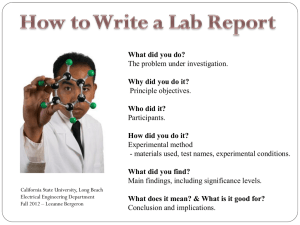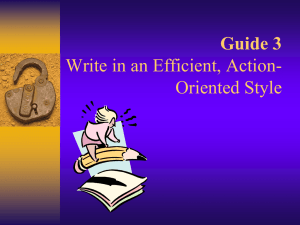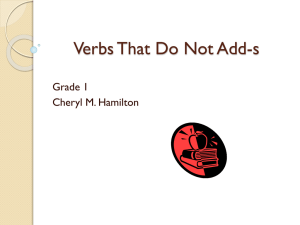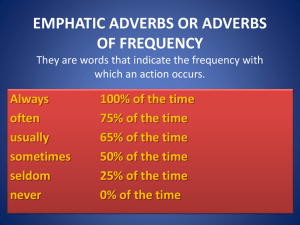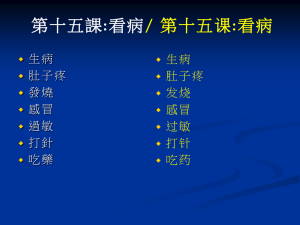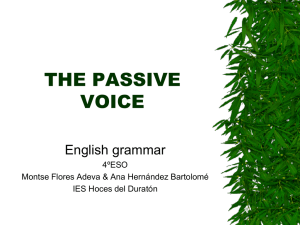Notes on Writing Technical Papers
advertisement
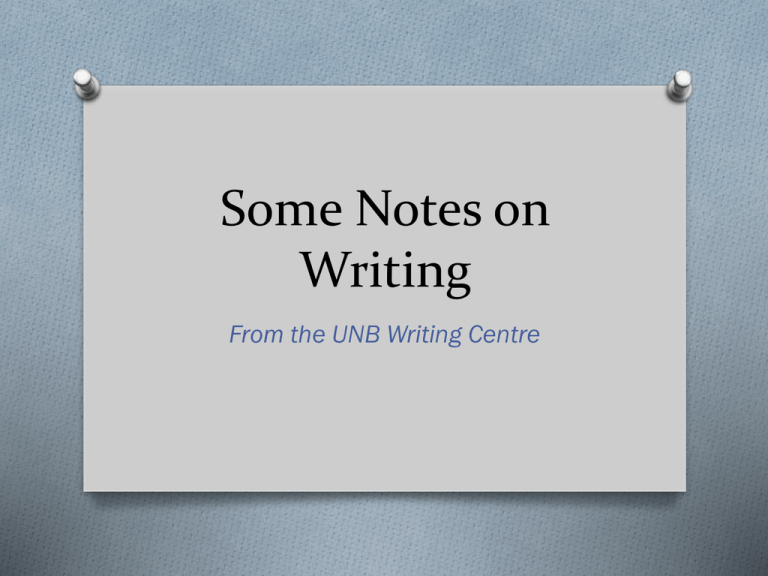
Some Notes on Writing From the UNB Writing Centre Topics 1. Structure: IMRaD & More 2. Bugbears, Diction, & Wordiness 3. Sentence Length & Coherence 4. Passive Voice 5. Limits of Self-Editing Structure O Outlines: O A formal plan serving as your guide to your thought O Writing it out externalizes it O Your own familiarity with your thought may blind you to your lack of a clear structure O Try not to rely on “blind writing” Structure IMRaD O Introduction, O Methods, O Results, and O Discussion. Introduction 1. What we know (lit. review) 2. What we don’t know (hypothesis) 3. What we did Literature Review O shows your understanding of the field O review the best studies available (most rigorously designed & executed) O avoid the temptation to include everything you reviewed (no matter how troublesome it was) Hypothesis/Research Question O the FIRST and LAST sentence you will write O sums up the whole point of the paper “We determined the relative effectiveness of three exercise regimens in promoting health and fitness.” Hypothesis/Research Question O Later in the process you may find it useful to add details. . . . “We determined the relative effectiveness of three exercise regimens, intense interval training, prolonged exercise, and strength training, in promoting health and fitness.” Hypothesis/Research Question O So that the final version of your research statement or question—the last sentence you write—is significantly different. “We determined the relative effectiveness of three exercise regimens, intense interval training, prolonged exercise, and strength training, in improving cardiorespiratory fitness, reducing body fat, and increasing total bone mass.” Methods O details of what you did O study design, participants, methods, data analysis O should only include details necessary for readers to judge your work/repeat your experiment Results O easy part: the key findings O again: avoid the temptation of presenting everything O focus on the general in the text and the specifics in the data tables Discussion O be open about limitations, inconsistencies O never draw unjustified conclusions O use appropriate validity markers Validity Markers a. b. c. hedges: perhaps, may, might, often, usually, apparently, seemingly emphatics (boosters): clearly, undoubtedly, it is obvious that, of course attributors: “according to Wilson (1999)” 2. Bugbears, Diction, & Wordiness (illus. Sir John Tenniel, Alice in Wonderland, by Lewis Carroll.) What Are Bugbears? O Grammatical howlers, frequently merely conventional or formal errors O Many do not impair the effectiveness of the communication O How important are they? Although high intensity interval training was suppose to increase bone density as well as VO2 max, it failed in this respect. Grammatical Bugbears O Cannot be ignored (“use to,” “should of,” “in regards to”) O Will always overshadow genuine achievement to some degree O Technology cannot yet save us-- MS Word May Not Help! Diction O Writing Apprenticeship: expansiveness and dilation have been emphasized over precision and economy It is time to choose O The right words and O Words your audience knows. Novelty & Vocabulary O “make it new” is not the always best advice for selecting words O Accuracy and familiarity (of individual words, not phrases) are crucial O The evil comes from overly familiar phrases and unnecessarily obscure words Complex Diction O What do people REALLY think of overly complex diction? Consequences of Erudite O D. Oppenheimer,Utilized Stanford U (2003): Vernacular O people who use unnecessarily complicated Irrespective of Necessity: language are viewed as less intelligent than people who use more familiar language Problems With Using Long Words Needlessly Ready-Made Phrases O Like Frankenstein's monster, "ready-made" writing is stitched together out of dead parts. O Avoid phrases that “sound appropriate” O Use only words you need—and your audience understands Basic Inflation • • • • • • Based on the fact that Due to the fact that Exhibit a tendency to For the purpose of For the reason that In spite of the fact that Because Because Tend to For Because Although Other Types of Repetition Redundant Adjectives/Adverbs O future plans O consensus of opinion O especially unique O potential hazard O final outcome Nominalizations allocation allocate assessment assess compliance comply determination determine expectations expect exposure expose [had] hopes [of] hoped Positive Advice O Find the VERB in the nominalization, and build the sentence around it O Strong verbs make clear sentences Where Does It Come From? O Most of these choices are the result of “length anxiety” O From early grades, length is the measure of achievement O Students learn to pad—to be honest, we teach them—and the habit becomes engrained O Editors then try to take it all out again 3. Sentence Length & Coherence O Writers are taught to vary the form and O O O O length of their sentences Length in the wrong place is dangerous Proceed with caution Selecting length with a clear purpose is one challenge Coherence is another What Length Means LENGTH 8 words 11 words 14 words 17-19 words 21-24 words 25-28 words 29+ words QUALITY very easy easy fairly easy standard fairly difficult difficult very difficult Long, Graceful Sentences O A long sentence can still be readable O Key tactic: Move from subject to verb quickly O Avoid delaying the subject-verb progression with long intervening elements O A sentence which moves from subject to verb rapidly will still be readable even when it is quite long To the Subject and Beyond Inferring from behavior the existence and nature of underlying but not observable mechanisms that mediate that behavior is for the cognitive behaviorist the fundamental research goal. 17-word subject—in a 26-word sentence ! To the Subject and Beyond The fundamental research goal of the cognitive behaviorist is inferring the existence and nature of underlying but not observable mechanisms that mediate behavior. 8-word subject—in a 23-word sentence ! To the Subject and Beyond Cognitive behaviorists infer the existence and nature of underlying but not observable mechanisms that mediate behavior. Better: a 2word subject— in a 16-word sentence ! Developing a Feel for Length O More gradual variations in length are possible O Increasing length can build to the climax of an argument O Length should always develop from the rhetorical goal O Never introduce variety for the sake of variety 4. Passive Voice O “There are several observations that could be made. . . .” O “It has been suggested that. . . .” Passive voice O Generally misunderstood, by Strunk & White among others O Passive verb construction: Object of transitive verb “to be” Past participle Preposition + Subject of transitive verb Passive voice O Generally misunderstood, by Stunk & White among others O Passive verb construction: The man was bitten By the dog Passive voice O Generally misunderstood, by Stunk & White among others O Passive verb construction: The test was written by 30 students. Expletives & Fog O It has been repeatedly asserted that. . . . O There are significant obstacles to the further investigation of. . . . O “it” and “there” have no antecedents; they are “expletives” rather than pronouns Editing & Memory • Let’s test yours Memorabilia 5. Why You Are Your Own Worst Editor O We see what we expect to see; O We interpret as we read; O At the same time, we know communication is robust—and so we are sometimes careless How Robust? There was nothing wrong with her way of handling the car; its engine was defective They're as nothing wring wither way of handing the care; its engine was deflective. Word: No Help Here General Principles O Keep track of your purpose and test each paragraph and sentence against it O Keep your audience in mind and write for them, not at them O Critique your own writing in relation to that purpose and audience O Have someone else read your writing Five Revision Rules Stick to the point O delete any irrelevant information, however interesting O you may be able to place it in the appendix O removing extra information makes what remains clearer 1. 2. Say what you mean O reading out loud helps O having another person read it helps more O never repeat a phrase you have read elsewhere unless you understand it thoroughly (the other writer may be wrong) 3. Keep forward momentum O repeat key words as necessary so that a clear argument develops O use appropriate connectives to ensure clear progress (example) Identify the connectives In saturated air (100% relative humidity), the worms lost about 20% of their initial body weight during the first 20 hours but were then able to prevent further dehydration. In contrast, worms maintained in air of 70-80% relative humidity experienced a much faster rate of dehydration, losing 63% of their total body water content in 24 hours. As a consequence of this rapid dehydration, most worms died within the 24hour period. In saturated air (100% relative humidity), the worms lost about 20% of their initial body weight during the first 20 hours but were then able to prevent further dehydration. In contrast, worms maintained in air of 70-80% relative humidity experienced a much faster rate of dehydration, losing 63% of their total body water content in 24 hours. As a consequence of this rapid dehydration, most worms died within the 24hour period. 4. Indicate interpretations O Signal all interpretations clearly The difference in absorption rates is evident in Table 1. What IS the difference? 4. Indicate interpretations O Signal all interpretations clearly Clearly, alcohol is more readily absorbed into the bloodstream from distilled, rather than brewed, beverages (Table 1). 5. Avoid overlap & repetition O Be concise. . . . Our results were based on observations of short-term changes in behavior. These results showed that feeding rates did not vary with the size of the caterpillar. 5. Avoid overlap & repetition O Be concise. . . . Our observations of short-term changes in behavior indicate that feeding rates did not vary with the size of the caterpillar. 5. Avoid overlap & repetition O Be concise. . . . Feeding rates did not appear to vary with the size of the caterpillar (Table 2). 6. Bonus Rule: Make Backups! O Most common error: saving OVER existing document O Difficult to reverse O Practice saving with a new name so this never happens Slideshow (and More) go.unb.ca/wss
